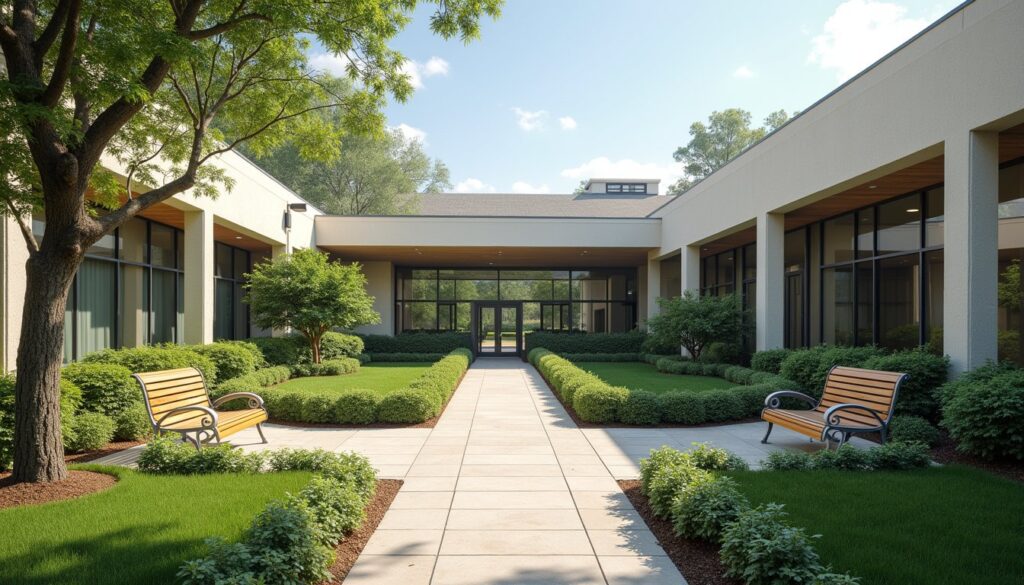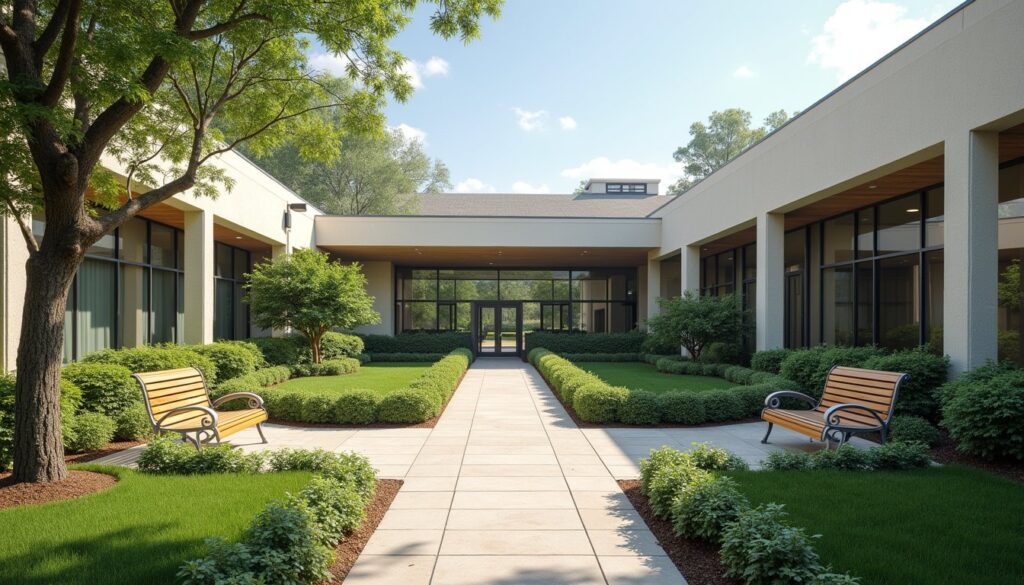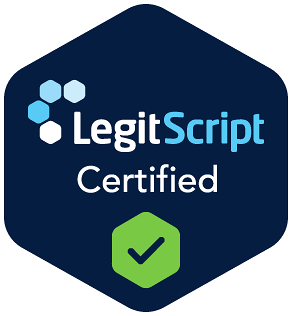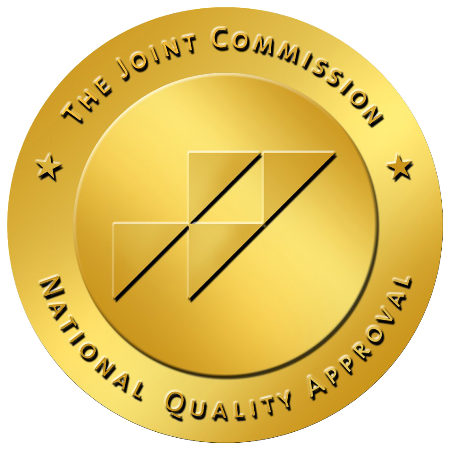When choosing a drug rehab center, you’ll want to verify key factors that directly impact your recovery success. Look for facilities with CARF or Joint Commission accreditation, experienced board-certified addiction specialists, and extensive medical detox capabilities. Consider the center’s treatment specializations, evidence-based methods, and aftercare support programs. Don’t forget to evaluate financial options, including insurance coverage and payment plans. Understanding these essential elements will help guide your path to successful rehabilitation.
Evaluating Accreditation and Licensing Standards

When searching for a drug rehabilitation center, understanding accreditation and licensing standards serves as your first line of defense in finding quality care. Look for facilities with CARF or Joint Commission accreditation, as these demonstrate a higher level of service beyond basic licensing requirements. Centers must undergo thorough peer reviews by industry experts during the accreditation process.
The accreditation importance lies in guaranteed evidence-based treatments, qualified staff, and rigorous safety protocols. Facilities that maintain ongoing review processes must regularly demonstrate their commitment to quality improvement. For additional security, most accredited centers employ security measures to protect patient data and privacy. You’ll find that accredited facilities must prove their effectiveness through outcome tracking and regular audits. While state licensing differences focus on legal minimums for operation, accreditation guarantees thorough care that includes specialized services for diverse populations.
Verify both licensing and accreditation status before making your decision. Remember, licensed facilities meet state requirements, but accredited centers voluntarily undergo extensive evaluation to maintain superior standards of care and treatment effectiveness.
Understanding Treatment Program Specializations
Treatment program specializations vary greatly across rehabilitation centers, making it vital to match your specific needs with the right type of care. When evaluating programs, you’ll want to take into account five key areas: substance expertise, therapeutic approaches, program structure, dual diagnosis capabilities, and aftercare strategies. Each aspect plays a significant role in your recovery journey. Insurance coverage under the Affordable Care Act makes accessing specialized treatment programs more feasible for many individuals seeking help. Clients can move between different care levels as their treatment needs evolve during recovery. Many facilities employ security measures to protect patient privacy and confidentiality during treatment.
| Specialization Area | What to Look For |
|---|---|
| Substance Expertise | Experience with your specific addiction type |
| Therapeutic Approaches | Evidence-based methods like CBT and MAT |
| Program Structure | Options from residential to outpatient care |
| Dual Diagnosis | Integrated mental health treatment |
| Aftercare Strategy | Continuous support and relapse prevention |
The best programs offer extensive care that addresses both addiction and any underlying conditions while providing clear pathways for long-term recovery through structured aftercare planning and ongoing support systems.
Assessing Medical Detox Capabilities

When evaluating a rehab center’s medical detox capabilities, you’ll need to verify that the facility employs board-certified physicians and licensed nurses with specialized addiction treatment credentials. You should confirm that the center maintains 24/7 medical supervision protocols for managing withdrawal symptoms, including regular essential sign monitoring and medication adjustments. The facility must also demonstrate clear emergency response plans with trained staff and equipment ready to handle critical situations like severe withdrawal complications or medical emergencies. Having expert addiction specialists on staff, like those at UF Health’s facility, ensures comprehensive medical oversight during detox. A quality medical detox program typically runs for five to seven days under careful physician supervision. Patients receive comprehensive care including IV fluids and vitamins to support their physical recovery during the detoxification process.
Medical Staff Credentials Required
Safety and success in medical detox hinge critically on the qualifications of medical staff overseeing the process. When evaluating a rehab center’s medical team, you’ll want to verify their credentials and specialty certifications through state medical boards. Look for facilities with board-certified addiction medicine specialists and physicians who maintain active licenses in their primary specialties. The facility must maintain ongoing credential maintenance to ensure continuous quality care and compliance with insurance requirements. The experience of qualified treatment professionals following state regulations directly impacts the quality of care provided during recovery. These medical professionals typically pursue continuing education credits through organizations like ASAM to stay current with the latest addiction treatment practices.
| Staff Role | Required Credentials |
|---|---|
| Medical Director | ASAM Board Certification |
| Physicians | State License, DEA Registration |
| Nurses | RN/LPN License, Detox Experience |
| Counselors | LAC/LADC/LPC Certification |
You should also confirm that the facility maintains proper documentation of staff qualifications, including background checks, malpractice insurance, and continuing education records. Centers accredited by CARF or Joint Commission typically adhere to stricter credentialing standards, ensuring higher quality care during your detox process.
24/7 Withdrawal Management Protocol
A thorough withdrawal management protocol forms the cornerstone of any effective medical detox program. When evaluating a rehab center, you’ll want to confirm they conduct extensive biopsychosocial screenings and physical examinations during intake to assess withdrawal severity and determine appropriate care levels.
Look for facilities that employ standardized assessment tools like CIWA-Ar for monitoring symptoms and adjusting treatment plans. Their medication management practices should include precise protocols for medications like buprenorphine, with clear timelines for initiation and dosage adjustments. The facility should maintain a calm environment that allows patients to rest while minimizing external stressors during the withdrawal process. The facility’s protocols should be regularly reviewed and updated by their program medical directors to ensure compliance with current guidelines. You’ll also want to verify they provide continuous monitoring of essential signs and maintain detailed documentation of all interventions. The center should prioritize monitoring patients every 4 to 8 hours until withdrawal symptoms stabilize.
The center should have established discharge planning that begins at admission, including aftercare coordination and referral networks for ongoing support services.
Emergency Response Readiness Plans
Because medical emergencies can arise unexpectedly during detox, you’ll need to carefully evaluate a facility’s emergency response capabilities before committing to treatment. Look for centers that maintain 24/7 medical supervision with staff certified in detox protocols and overdose preparedness. The facility should have extensive crisis intervention systems, including same-day admission protocols and rapid response teams for acute situations.
Treatment centers should focus on addressing co-occurring disorders alongside substance use, as mental health issues frequently accompany addiction. Verify that the center has established Naloxone distribution protocols and partnerships with local emergency departments. You’ll want to confirm they offer medication-assisted treatment options with individualized detox plans and constant monitoring. The best facilities integrate evidence-based interventions while providing immediate access to specialists during emergencies. Their emergency response plans should also include detailed documentation systems and clear procedures for managing withdrawal complications or potential overdose situations.
Examining Staff Credentials and Experience

When selecting a drug rehabilitation center, understanding staff credentials and experience becomes a critical factor in your decision-making process. You’ll want to verify that the facility maintains high standards for staff qualifications and emphasizes experiential learning through ongoing professional development.
Key credentials and experience to look for include:
- Licensed clinical professionals (LCSW, CADC) who specialize in addiction treatment
- Medical staff with expertise in detox and medication management
- Dual-diagnosis specialists who can address co-occurring mental health conditions
- Clinical supervisors (CS) who oversee treatment quality and protocols
- Peer recovery specialists (PR, PR-A) who provide valuable lived experience support
Don’t hesitate to ask about staff certifications, continuing education requirements, and background checks. A well-credentialed team greatly impacts the quality of care you’ll receive during your recovery journey.
Analyzing Treatment Methods and Approaches
Understanding the diverse treatment methods and approaches available at rehab centers will help you make an informed decision about your recovery journey. You’ll find various treatment modalities ranging from intensive inpatient care to flexible outpatient programs, each designed to meet different levels of addiction severity and personal circumstances.
When evaluating centers, consider their therapeutic techniques. Look for facilities that offer evidence-based approaches like cognitive-behavioral therapy, group sessions, and individual counseling. If you’re dealing with severe addiction, you might benefit from medically supervised detox followed by residential treatment. For moderate cases, partial hospitalization or intensive outpatient care could provide the right balance. Don’t overlook centers that incorporate holistic methods like mindfulness and art therapy, as these can complement traditional treatments and support your overall recovery process.
Reviewing Success Rates and Patient Outcomes
Success rates and patient outcomes offer essential insights into a rehab center’s effectiveness at treating specific addictions. When evaluating success metrics, you’ll find that recovery timelines vary greatly across different substance use disorders and treatment approaches.
Understanding treatment success rates helps identify quality rehab programs, though recovery paths differ significantly among addiction types and therapeutic methods.
Consider these key patient outcome indicators when selecting a facility:
- Treatment completion rates ranging from 68% for detox programs to varying percentages based on addiction type (50-60% for alcohol, 30-50% for opioids)
- Post-treatment support systems, including family engagement and peer groups, which greatly reduce relapse risk
- Quality of individualized care and aftercare programs that enhance long-term recovery success
- Program duration and intensity matching your specific needs and addiction type
- Evidence of improved quality of life among previous patients, with 70% reporting positive changes within one year
Exploring Facility Amenities and Environment
The quality of a rehabilitation facility’s amenities and environment plays a crucial role in your recovery journey. When evaluating facilities, you’ll want to take into account both medical services and the facility atmosphere that supports your healing process.
| Amenity Type | Common Features | Impact on Recovery |
|---|---|---|
| Medical Services | Drug screening, Health testing | Guarantees safe detox and monitoring |
| Treatment Spaces | Individual/group therapy rooms | Supports various therapy modalities |
| Health Facilities | Smoking areas, Exercise spaces | Promotes physical well-being |
| Clinical Resources | Assessment rooms, Testing labs | Enables thorough care |
| Recreational Activities | Community spaces, Outreach areas | Encourages social integration |
You’ll find that facilities offering thorough medical services, comfortable treatment spaces, and structured recreational activities create an environment more conducive to recovery. Reflect on whether the center provides interim care options and community integration support to help you maintain long-term sobriety.
Verifying Insurance Coverage and Financial Options
When exploring rehab options, you’ll want to verify your insurance network status by having the facility conduct a free, confidential benefits check that outlines your coverage levels and in-network providers. Your out-of-pocket costs will depend on your specific plan’s deductibles, copays, and coverage limits, which the facility’s financial advisors can help you understand and plan for. If you’re underinsured or facing high costs, many quality rehab centers offer flexible payment plans, sliding scale fees, and assistance programs to help make treatment more accessible.
Insurance Network Status Check
Steering through insurance coverage for drug rehabilitation requires a thorough verification process to confirm proper network status and financial clarity. A detailed insurance eligibility verification helps determine your coverage limitations analysis and guarantees you receive the maximum benefits available under your plan.
- Gather essential documentation including your policy number, member ID, and insurance provider contact information before initiating verification
- Contact the treatment facility to confirm their network status and coordinate insurance verification with their administrative team
- Utilize online verification tools for instant coverage checks and preliminary benefit assessments
- Review your financial responsibilities including deductibles, copayments, and coinsurance amounts
- Maintain clear communication between your provider and insurance company throughout the verification process
This systematic approach helps avoid unexpected costs and guarantees you can focus on your recovery journey rather than administrative concerns.
Payment Plans and Assistance
Beyond insurance coverage verification, exploring extensive payment plans and financial assistance options opens additional pathways to affordable treatment. You’ll find multiple financial solutions, from sliding-scale fees based on your income to interest-free installment agreements. Government programs like SAMHSA grants and Medicaid can greatly reduce your out-of-pocket expenses.
| Payment Option | Benefits | Requirements |
|---|---|---|
| Sliding Scale | Adjusted to income | Proof of earnings |
| Payment Plans | Interest-free options | Good payment history |
| HSA/FSA | Tax advantages | Employer participation |
| Government Aid | Full/partial coverage | Eligibility criteria |
| Grant Programs | No repayment needed | Application process |
Don’t overlook state-funded facilities and community resources that offer free or low-cost care. Your treatment center’s financial counselor can help navigate these options and negotiate payment terms that fit your circumstances.
Out-of-Pocket Cost Breakdown
Understanding your insurance coverage represents the crucial first step in managing treatment costs, as coverage rates vary greatly across different substances and demographics. Financial transparency from rehab centers helps you anticipate out-of-pocket expenses and plan accordingly.
- Private insurance typically covers only 13.4% of substance use disorder treatments, with 1 in 5 adults uncertain about their plan’s coverage
- Medicaid coverage ranges from 37.2% for opioid treatment to 13.1% for stimulant-related care
- Medicare won’t cover non-hospital residential treatment, creating significant gaps for older adults
- Continuous coverage leads to better treatment outcomes, with 79.04% accessing outpatient care versus 53.39% for uninsured
- Your referral source impacts costs – employer/EAP referrals show higher private coverage (43%) while criminal justice referrals face higher uninsured rates (67.5%)
Investigating Aftercare Support Programs
Selecting an effective aftercare support program can make the difference between sustained recovery and potential relapse. You’ll want to look for centers that offer structured programs with thorough plans and attendance contracts, as these elements can double your engagement rates and greatly reduce relapse risks.
Pay close attention to facilities that integrate social reinforcement through peer support and skills coaching. These components are essential for maintaining aftercare engagement and building your confidence in managing triggers. The most successful programs combine multiple approaches, including ongoing feedback, regular check-ins, and relapse prevention training. Studies show that active participation in well-designed aftercare programs can boost your chances of long-term success by up to 80%, compared to just 20% without structured support.
Checking Family Involvement Opportunities
When evaluating drug rehab centers, family involvement can greatly influence your recovery success. Research shows that family engagement considerably improves treatment readiness and completion rates, with some programs reporting up to 92% success rates for parents in recovery.
Look for facilities that offer these essential family involvement components:
- Residential options that allow parents to live with their children during treatment
- Family-focused behavioral therapy sessions and support tools
- Digital communication platforms for ongoing family connection via phone/text
- Specialized programs for pregnant women and parents with integrated child services
- Evidence-based interventions like YORS that incorporate family strategies for medication management
These features not only boost your chances of successful recovery but also strengthen family bonds, with studies showing 75% sustained recovery rates at 12 months when families actively participate.
Frequently Asked Questions
Can I Bring My Personal Electronic Devices During Treatment?
Most treatment centers restrict personal devices during early recovery phases to help you focus fully on healing. Treatment protocols typically include a 3-day hold on electronics upon admission, with supervised access allowed for emergencies. You’ll likely need to store your devices securely at the facility. As you progress in treatment, you may earn privileges for limited device use. It’s best to check specific policies with your chosen facility beforehand.
What Items Are Restricted or Prohibited in the Facility?
You’ll need to follow strict facility rules regarding prohibited items for everyone’s safety and recovery success. Common restrictions include substances like drugs, alcohol, and unapproved medications; hazardous items such as weapons, aerosols, or sharp objects; electronic devices with cameras or internet access; and certain personal care items containing alcohol. Don’t bring outside food/drinks, inappropriate clothing, or personal bedding unless specifically approved by the facility.
How Often Can I Receive Visitors During My Stay?
Your ability to receive visitors will vary based on your treatment phase and the facility’s visitor policies. During detox, you typically won’t have visitors to focus on stabilization. As you progress, you’ll gain more family involvement opportunities, often starting with weekly or biweekly visits. You’ll need to get advance approval from your therapist, and all visits must be scheduled. Remember that your treatment progress and compliance with program rules will influence your visitation privileges.
Are There Designated Smoking Areas Within the Facility?
Most rehab facilities provide designated outdoor smoking areas, but you’ll need to check specific smoking policies at each center. You’ll typically find that up to 90% of facilities allow smoking outdoors with varying time restrictions. Indoor smoking is rare, permitted in only 10% of centers. Some facilities may require unopened cigarette packs and restrict smoking to specific outdoor locations and times. It’s best to ask directly about the facility’s current policy.
Can I Continue Working or Attending School During Treatment?
Yes, you can often continue working or attending school during treatment, depending on the program’s flexibility and your specific needs. Many outpatient programs offer scheduling options that support work-life balance, allowing you to maintain your professional or academic commitments while receiving care. If you’re employed, you may also have legal protections and workplace accommodations available. Your treatment team will help create a plan that aligns with your recovery goals and daily responsibilities.













